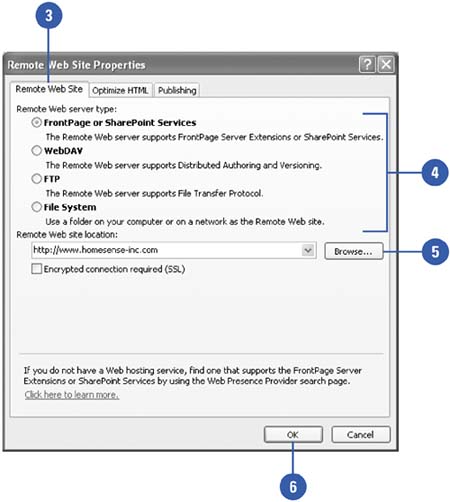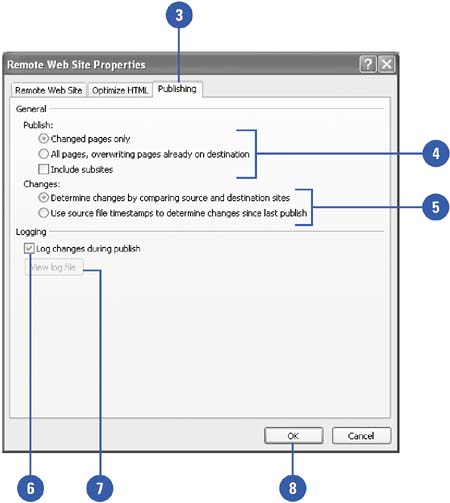Using Remote Site View
The Remote Site view allows you to compare the content of the current local Web site and a target remote Web site. Typically, the local Web site contains the development version of a site and the remote Web site on a Web server contains the "live" site on the Internet. Using Remote Site view, you can publish an entire Web site or individual files. If you display Remote Site view for a site you have not published, a blank window appears with the message Click "Remote Web Site Properties..." to setup a remote site. You can publish your files to a Web site with FrontPage Server Extensions or SharePoint Team Services, WebDAV (Distributed Authoring and Versioning), FTP (File Transfer Protocol), or Windows file system.
Specify the Remote Web Site Location
 | Open the Web site you want to publish, click the View menu' and then click Remote Web Site. |
 | Click the Remote Web Site Properties button. |
 | Click the Remote Web Site tab. |
 | Click the option with the remote Web server type in which you want to publish your files. |
FrontPage or SharePoint Services.
The site is running FrontPage Server Extensions or Windows SharePoint Services; use http://URL.
WebDAV.
The site supports WebDAV; use http://URL.
FTP.
The site supports FTP; use ftp://URL.
File System.
The site resides on a local or network drive; use C:\MyWeb or \\Server\MyWeb.
 | Type the remote Web site location or use Browse to select it. |
 | Click OK. |

Change Publishing Properties
 | Open the Web site you want to publish, click the View menu' and then click Remote Web Site. |
 | Click the Remote Web Site Properties button. |
 | Click the Publishing tab. |
 | Click the publish options you want. |
Changed Pages Only All Pages, Overwriting Pages Already On Destination Include Subsites. Select the check box to publish all Web sites contained within the main Web site.
 | Click the option you want to specify how FrontPage compares file in the two Web sites. |
 | To keep a log of changes, select the Log Changes During Publish check box. |
 | To display the log for the most recent publish operation, click View Log File. |
 | Click OK. |

|
Entering the Publishing Destination
When you publish your site to a folder on your local file system, you enter a location using the syntax C:\\sitefolder, where C is the drive letter. When you publish your site to a folder on a network server, you enter a location using the Universal Naming Conventions (UNC). UNC is a convention that produces a machine-independent way to locate a file. The UNC name employs the syntax \\server\share\path\foldername. When you publish your site to a folder on a Web server on the World Wide Web, you enter a Uniform Resource Locator (URL). A URL consists of three parts: the prefix http://, which indicates a Web address; a network identification, such as www for the World Wide Web; and a Web site name, or domain name, such as homesense-inc.com. |
|